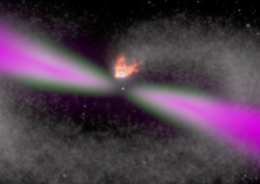Black widow pulsars are cruel, fascinating beasts that have understandably attracted much attention. Recently, a new set of radio observations has shined light not on the pulsars themselves, but on the properties of their unlucky victims.
Cruel Stars
Black widow pulsars, as their name suggests, easily rank among the deadliest creatures that roam our galaxy. These vicious beasts are a member of the pulsar family, meaning they are dense balls of neutrons formed during the collapse of a massive star. Similarly to a more peaceful (though still quite energetic) subset of their pulsar brethren, they spin so rapidly that they complete one rotation in less than a hundredth of a second. Unlike their docile counterparts, however, each black widow has trapped a low-mass companion into a nearby orbit. These companions, usually a small star or a brown dwarf, feel the full force of the intense radiation spewing from their captors. As the companion helplessly circles the pulsar, this radiation strips material away and peels the object apart. Eventually, the companion meets the same fate as the insolent soldiers who gazed upon forbidden artifacts in Steven Spielberg’s Raiders of the Lost Ark: they melt into nothingness, unable to withstand the heat.

An illustration of a black widow pulsar that includes the tail of the disintegrating companion. [NASA’s Goddard Space Flight Center]
An Unwilling Comet
As the doomed brown dwarf completes laps around the pulsar, the material blown off forms a long tail extending behind it, much like a scaled-up comet. This material slightly impedes our view of the system from Earth, and with periodic regularity, it causes different properties of the observed radio emission to shift around. The simplest of these properties is the brightness of the emission: When the densest part of the comet-like tail falls into our line of sight to the pulsar, some low frequencies are blocked entirely, while higher frequencies manage to shine straight through. These “eclipses” have been seen in this system and others in the past, and the range of frequencies blocked can help constrain the environment of the tail.

Different measured quantities as a function of the brown dwarf’s orbital phase. The bottom plot show the rotation measure: the authors attribute the decrease between the dash-dotted and dashed vertical line to the tail’s magnetic field. [Adapted from Wang et al. 2024]
During the main eclipse, the relatively dense, turbulent material of the tail leaves the polarization scrambled in a way that makes it difficult to measure the RM. However, during the egress of the eclipse when the tail begins to thin out, Wang and collaborators discovered that the RM steadily decreased until it reached its steady, out-of-eclipse value. They infer that this shift is due to a magnetic field in the tail: the material that used to make up the outer atmosphere of the brown dwarf is slightly magnetized with a field strength of about 0.1 Gauss, a little weaker than Earth’s magnetic field at the surface.
Novel, For Now
The researchers note that this is the first time this orbital-phase-dependent change in the RM has been observed, meaning that it’s also the first precise measurement of the magnetic field in the material blown away from black widow’s a companion. However, with FAST now fully operational and proven capable of this kind of measurement, similar observations are likely to follow. We’re likely about to learn much more about the tragic futures of these low-mass companions, and in doing so, more about the pulsars that will bring about about their demise.
Citation
“Change of Rotation Measure during the Eclipse of a Black Widow PSR J2051−0827,” S. Q. Wang et al 2023 ApJ 955 36. doi:10.3847/1538-4357/acea81

